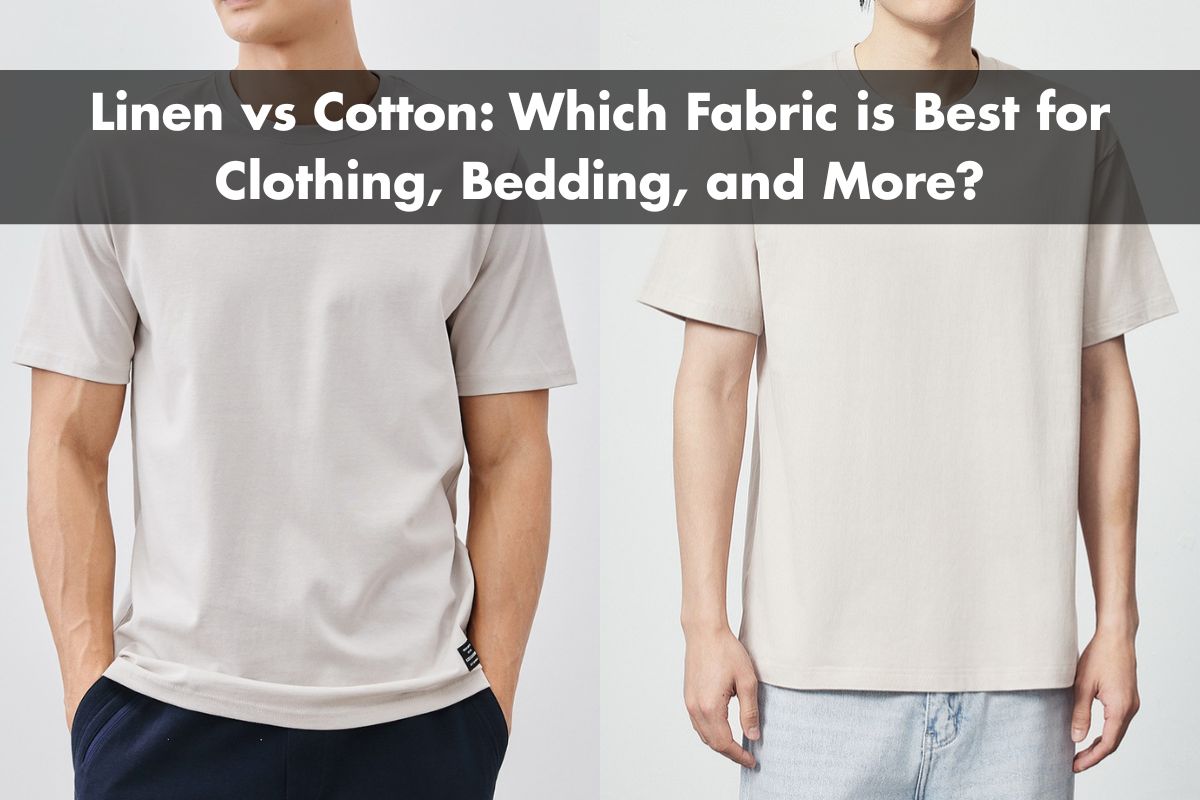Choosing between linen and cotton can feel like a tough decision, especially when both fabrics offer unique qualities. Whether you're shopping for clothing, bedding, or home essentials, understanding the differences can help you make the right choice for your needs.
In this article, I’ll break down the key factors like texture, durability, and performance to help you decide which fabric suits your lifestyle best. Whether you're drawn to linen’s timeless charm or cotton’s cozy appeal, there’s a lot to consider. Let’s dive into what sets these two fabrics apart.
What is Linen?
Linen is a natural fabric made from the fibers of the flax plant. These fibers are among the strongest in the textile industry, making linen highly durable. The production process involves harvesting flax, extracting the fibers, spinning them into yarn, and weaving them into fabric.
Known for its textured surface, linen feels crisp and slightly coarse but softens with every wash. Its looser weave and distinct patterns create a rougher look compared to cotton, adding depth and character to its appearance.
Linen is exceptionally breathable and moisture-wicking, making it ideal for warm climates. It's capable of absorbing more moisture than cotton without feeling damp, which helps keep the body cool and dry during humid conditions. Additionally, its natural fibers resist odors and stains better than many other fabrics.
Prized for its longevity, linen can last decades when properly cared for. It becomes softer over time, further enhancing its luxurious feel. While linen tends to wrinkle more easily due to its rigid structure, this feature often adds to its charm, offering a relaxed, lived-in aesthetic.

What Are Cotton and Cotton Blends?
Cotton is a natural fabric made from the soft, fluffy fibers encased in the boll of the cotton plant, which belongs to the genus Gossypium. The fibers are spun into thread and tightly woven into fabric, creating a material known for its smooth texture, durability, and versatility. Cotton's staple fibers vary in length, with longer fibers found in high-quality varieties like Egyptian cotton, which results in a softer and more durable final product.
Cotton blends are textiles that combine cotton fibers with other materials like polyester, rayon, or linen to create hybrid fabrics. These blends often enhance specific characteristics, such as durability, wrinkle resistance, or ease of care. For example, a cotton-polyester blend maintains cotton's softness while reducing shrinkage and improving moisture-wicking properties. Similarly, cotton-linen blends balance softness with breathability, offering a smoother texture than pure linen and more structure than pure cotton.
What Are The Characteristics and Uses Of Cotton?
Cotton, derived from the soft fibers of the cotton plant, stands as one of the most versatile and widely used materials globally. Its smooth texture and inherent softness make it a popular choice for many applications, from everyday clothing to home essentials.
Characteristics of Cotton
- Softness: Cotton offers a naturally smooth and soft texture, making it comfortable against the skin.
- Breathability: Its breathable structure allows air circulation, which prevents overheating, especially in warm climates.
- Durability: While not as strong as linen, cotton still withstands wear and tear with proper care, especially in denser weaves.
- Absorbency: Cotton fibers retain water effectively, making it an excellent material for items like towels and bathrobes.
- Hypoallergenic Nature: Cotton minimizes skin irritation due to its natural composition, suiting individuals with sensitivities.
Common Uses of Cotton
- Clothing: Cotton dominates the apparel industry. It's found in T-shirts, pants, hoodies, dresses, and undergarments due to its comfort and adaptability.
- Bedding: Bedsheets, pillowcases, and duvet covers frequently feature cotton for their soft and breathable qualities.
- Home Decor: Items like curtains and rugs utilize cotton for its versatility and easy maintenance.
- Medical Materials: Hypoallergenic and absorbent properties make cotton a primary component in bandages, gauze, and other medical textiles.
- Blended Fabrics: Cotton often combines with synthetic fibers or linen to enhance durability, wrinkle resistance, or softness, catering to specific needs.
Cotton's accessibility, ease of production, and widespread functionality contribute to its timeless appeal across industries and households.

Linen vs Cotton Fair Comparison
Fiber Source
Linen comes from flax plant stem fibers, making it rigid and robust, while cotton is derived from the fluffy fibers around cotton seed bolls, resulting in softness. Flax fibers create linen with a textured finish, and cotton’s shorter fibers give it a smoother, pliable appearance.
Texture and Feel
Cotton feels soft and smooth due to its tight weave and fine fibers, while linen's coarser texture, created by its loose weave, adds character. Linen steadily softens with washes, whereas cotton starts soft from its first use.
Durability
Linen surpasses cotton in longevity because of flax fibers' strength and tightly wrapped cellulose structure. Cotton features more flexibility but tends to wear out faster under regular use compared to linen.
Breathability
Linen's hollow strands and loose weave enhance airflow, keeping it cooler and more breathable than tightly woven cotton. Loosely woven cotton also offers breathability, but linen edges out in warm climates with better moisture regulation.
Absorbency
Both fabrics exhibit strong water absorption, though linen absorbs up to 20%, and cotton slightly more, at 25% of its weight. These properties suit both materials for towels and moisture-sensitive products.
Appearance and Wrinkling
Cotton appears smooth, with minimal pilling on higher-quality varieties, while linen retains a textured, sharp look that evolves into a softened vintage finish. Linen wrinkles easily due to its rigidity, giving it a laid-back aesthetic, while cotton resists creasing better for a polished appearance.
Moisture-Wicking
Linen outperforms cotton in absorbing and quickly releasing moisture, ensuring dryness in hot or humid conditions. Cotton absorbs moisture well but holds it longer, making linen more suited for optimal moisture management.
Use Cases
Cotton is ideal for everyday wear and bedding, offering comfort and versatility. Linen, with its durability and breathability, shines in specialized uses such as summer apparel, high-quality furnishings, and specific weather-resistant items.
What Are The Characteristics and Uses of Linen?
Linen, made from flax fibers, is celebrated for its durability, moisture-wicking abilities, and crisp texture. Its natural properties make it a versatile choice across various settings, especially in warm climates and eco-conscious environments.
Comfort and Breathability
Linen’s loosely woven structure allows for exceptional airflow, keeping the body cool in warm temperatures. This natural breathability, paired with its moisture-wicking attributes, makes it ideal for hot, tropical weather. It absorbs and releases moisture without feeling damp, enhancing comfort. While softening with washing, linen retains its signature textured surface that elevates everyday wear.
Suitability for Different Climates
Hot Weather: Linen outperforms other fabrics in arid climates thanks to its ability to wick away sweat and maintain dryness. Its quick-drying nature ensures optimal comfort during summer heat.
Cold Weather: While linen excels at temperature regulation, it’s less effective in cold conditions unless layered. However, its insulation properties can help retain warmth to a degree.
Moisture Handling
Linen absorbs moisture efficiently, drawing it away from the body and drying rapidly, a key advantage in hot and dry environments. Its odor-resistant properties reduce the frequency of washes, making it practical for extended use. This performance, combined with its antibacterial nature, makes it suitable for people prioritizing freshness and hygiene.
Wrinkle Resistance
Linen wrinkles easily, which adds an informal, textured charm to its appearance. While this attribute suits casual or bohemian styles, it might require extra care for formal wear. Steam or light ironing can restore a smoother look when needed.
Eco-Friendliness
Linen is one of the most sustainable fabrics available. Flax cultivation consumes less water than other crops, and the plant thrives without the need for heavy chemical fertilizers or pesticides. Linen is biodegradable, making it a preferred choice for reducing environmental impact.
Timeless Style
Linen’s natural luster and textured finish create a relaxed yet refined aesthetic. Its versatility supports a range of clothing, from elegant summer dresses to tailored outfits that work for informal or semi-formal settings. As it softens with use, it gains a lived-in elegance that’s both stylish and enduring.
What's Better for Fashion?
Linen offers a breezy and relaxed style ideal for casual summer clothing. Its loose weave enhances airflow, keeping the body cool in hot climates, while its textured finish adds character to garments like shirts, dresses, and trousers. Linen’s distinctive wrinkles contribute to a laid-back, natural look. However, this wrinkling may require additional care, such as steaming, to maintain a polished appearance for formal attire.
Cotton delivers versatility across seasons and occasions due to its softness and smooth texture. Lightweight cotton works well for summer outfits, while heavier weaves provide warmth in cooler months. With its wide-ranging styles, from everyday wear to professional looks, cotton is adaptable for both casual and structured designs. It's also less wrinkle-prone, reducing maintenance time for daily fashion needs.
Durability differences also influence their suitability for fashion. Linen’s fiber strength outlasts cotton, ensuring longevity for high-use items like summer dresses and tailored pieces. Cotton facilitates flexibility, making it better for fitted and stretchy garments where comfort and range of motion are important.
Both fabrics have distinct roles in fashion. Linen shines in breathable, effortlessly stylish looks for warmer weather, while cotton supports year-round wear with its smooth, versatile appeal.
Conclusion
Choosing between linen and cotton ultimately comes down to your personal needs and preferences. Both fabrics bring unique qualities to the table, whether it's linen's timeless texture and breathability or cotton's unmatched softness and versatility. By understanding their characteristics and how they align with your lifestyle, you can confidently decide which fabric suits you best. Whether you're prioritizing durability, comfort, or style, both options offer incredible value in their own ways.













